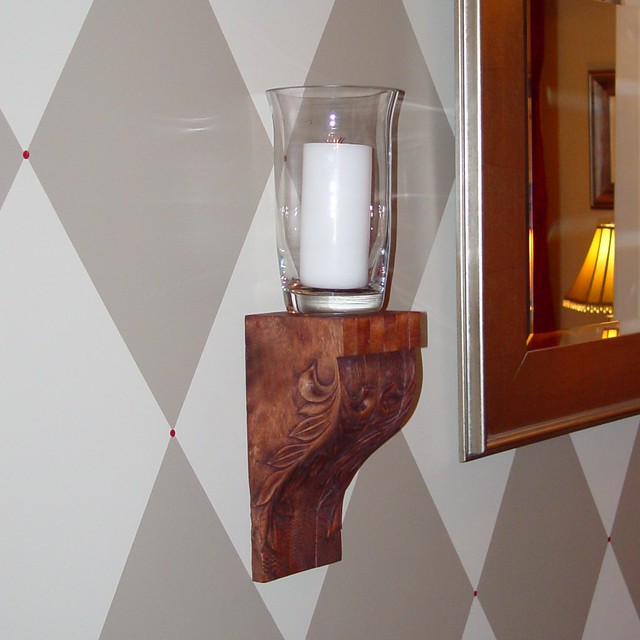Last week Wendy wrote about one of her principal design philosophies when decorating a room: incorporating at least one unique or one-of-a-kind item in every room. One of the items she briefly touched on were the decorative corbels that we have hanging in our front hallway.
I've always loved this decorative element of our home because they are unexpected in their current location, and they are a re-purpose from an old building. Originally an exterior architectural element of a somewhat ornate building, these probably adorned the facade high up under the roof's eaves. Even though elements like these were far off the ground, they were still given great attention to detail through intricate carvings. Over the years they received layer after layer of paint, losing most of their detail with each coat.
There is an area just west of Cleveland, Ohio, starting at the West Side Market and extending down Lorain Avenue, that has several "antique stores." I put that in quotes because the stores more typically house a collection of architectural salvage, junk, distressed, garage sale, consignment, and other interesting items more than "antiques." Wendy and I used to hit all of our favorite shops along Lorain Avenue every time we went home. If not to buy anything, just to see the interesting characters that tend to run and own the places. Cleveland definitely has its charm. If you're ever up that way, I encourage you to check it out.
Back in 2003, during one of our trips home, we found these two lovely corbels in the basement of a shop called "Reincarnation." They were dirty, in multiple pieces, covered in paint, and had missing pieces of what looked like trim. Wendy saw them and their potential, and picked up the pair for just $10.
When we got them home, we decided that we wanted to strip them of their paint before we figured out what we were going to do with them. To do this, I made a small bath of Bix stripper in a disposable tray and started laying the pieces into the bath to soak.
After about an hour in the bath, I would check the progress of the paint removal. If it looked good, I would remove the wood, wipe off what I could, and then set it aside to dry. This paint was stubborn, so it took several attempts before we achieved our desired results.
The more we stripped, the more the glue that had held the corbels together failed, until almost all of the cross sections had split apart. So we set up a stripping station in the basement so I could keep track of all of the pieces.
Once everything was dipped and stripped, I lightly sanded the surface with steel wool to remove any paint residue, then started to glue all of the sections back together. I also drilled through the center of the pieces and inserted a wood dowel into the middle of each one. I figured that it would keep the pieces from coming apart in the future.
You could finally see all of the very intricate details that had been covered by the paint. Once all the glue had dried, I gave each corbel another light scrape with dental tools to get dislodge any remining paint, and then gave them one final light sanding with steel wool. Once we were happy with the paint removal, we applied our stain. I believe we used "cherry" from Min-Wax.
The photo above really shows how the stain brought out the details of the carving. We let the stain dry and then polyurethaned the surfaces.
Wendy decided these would look great as wall mounted candle holders in our entry hall. The narrow hallway meant we needed to keep the floor free of any sort of tables or stands, but we wanted candles and some texture so it wasn't just a long hallway, so these were perfect. Since we were hanging this on the wall, we cut a small groove in the back of each one using a drill and a keyhole bit. That would allow the back to accept a screw head to hang on and sit flush against the wall.
For a very inexpensive and relatively easy project, we were and are still very happy with the results. There are probably thousands of corbels out there just waiting for you to rescue them for your house. Be sure to keep an eye out for them at your local junk or salvage store, and think about different ways you can incorporate them into your home as a one-of-a-kind accent.
Have you used some architectural salvage in an interesting way? Maybe in a doorway, or as a shelf bracket? If so, please let us know.

![]()
![]()